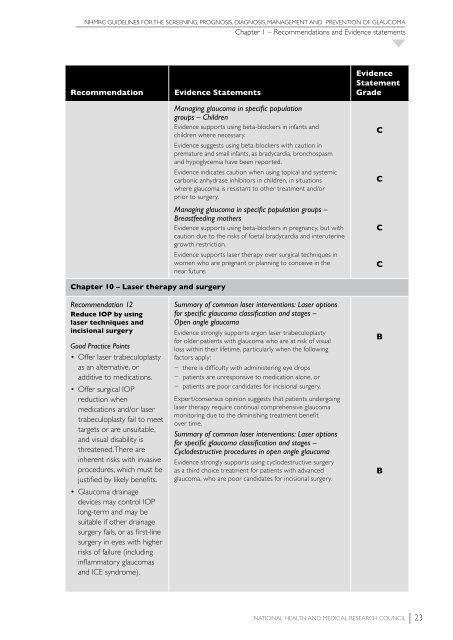NHMRC Glaucoma Guidelines - ANZGIG
NHMRC Glaucoma Guidelines - ANZGIG
NHMRC Glaucoma Guidelines - ANZGIG
Create successful ePaper yourself
Turn your PDF publications into a flip-book with our unique Google optimized e-Paper software.
<strong>NHMRC</strong> GUIDELINES FOR THE SCREENING, PROGNOSIS, DIAGNOSIS, MANAGEMENT AND PREVENTION OF GLAUCOMA<br />
Chapter 1 – Recommendations and Evidence statements<br />
Recommendation<br />
Evidence Statements<br />
Managing glaucoma in specific population<br />
groups – Children<br />
Evidence supports using beta-blockers in infants and<br />
children where necessary.<br />
Evidence suggests using beta-blockers with caution in<br />
premature and small infants, as bradycardia, bronchospasm<br />
and hypoglycemia have been reported.<br />
Evidence indicates caution when using topical and systemic<br />
carbonic anhydrase inhibitors in children, in situations<br />
where glaucoma is resistant to other treatment and/or<br />
prior to surgery.<br />
Managing glaucoma in specific population groups –<br />
Breastfeeding mothers<br />
Evidence supports using beta-blockers in pregnancy, but with<br />
caution due to the risks of foetal bradycardia and interuterine<br />
growth restriction.<br />
Evidence supports laser therapy over surgical techniques in<br />
women who are pregnant or planning to conceive in the<br />
near future.<br />
Evidence<br />
Statement<br />
Grade<br />
C<br />
C<br />
C<br />
C<br />
Chapter 10 – Laser therapy and surgery<br />
Recommendation 12<br />
Reduce IOP by using<br />
laser techniques and<br />
incisional surgery<br />
Good Practice Points<br />
• Offer laser trabeculoplasty<br />
as an alternative, or<br />
additive to medications.<br />
• Offer surgical IOP<br />
reduction when<br />
medications and/or laser<br />
trabeculoplasty fail to meet<br />
targets or are unsuitable,<br />
and visual disability is<br />
threatened. There are<br />
inherent risks with invasive<br />
procedures, which must be<br />
justified by likely benefits.<br />
• <strong>Glaucoma</strong> drainage<br />
devices may control IOP<br />
long-term and may be<br />
suitable if other drainage<br />
surgery fails, or as first-line<br />
surgery in eyes with higher<br />
risks of failure (including<br />
inflammatory glaucomas<br />
and ICE syndrome).<br />
Summary of common laser interventions: Laser options<br />
for specific glaucoma classification and stages –<br />
Open angle glaucoma<br />
Evidence strongly supports argon laser trabeculoplasty<br />
for older patients with glaucoma who are at risk of visual<br />
loss within their lifetime, particularly when the following<br />
factors apply:<br />
−−<br />
there is difficulty with administering eye drops<br />
−−<br />
patients are unresponsive to medication alone, or<br />
−−<br />
patients are poor candidates for incisional surgery.<br />
Expert/consensus opinion suggests that patients undergoing<br />
laser therapy require continual comprehensive glaucoma<br />
monitoring due to the diminishing treatment benefit<br />
over time.<br />
Summary of common laser interventions: Laser options<br />
for specific glaucoma classification and stages –<br />
Cyclodestructive procedures in open angle glaucoma<br />
Evidence strongly supports using cyclodestructive surgery<br />
as a third choice treatment for patients with advanced<br />
glaucoma, who are poor candidates for incisional surgery.<br />
B<br />
B<br />
National Health and Medical Research Council 23





